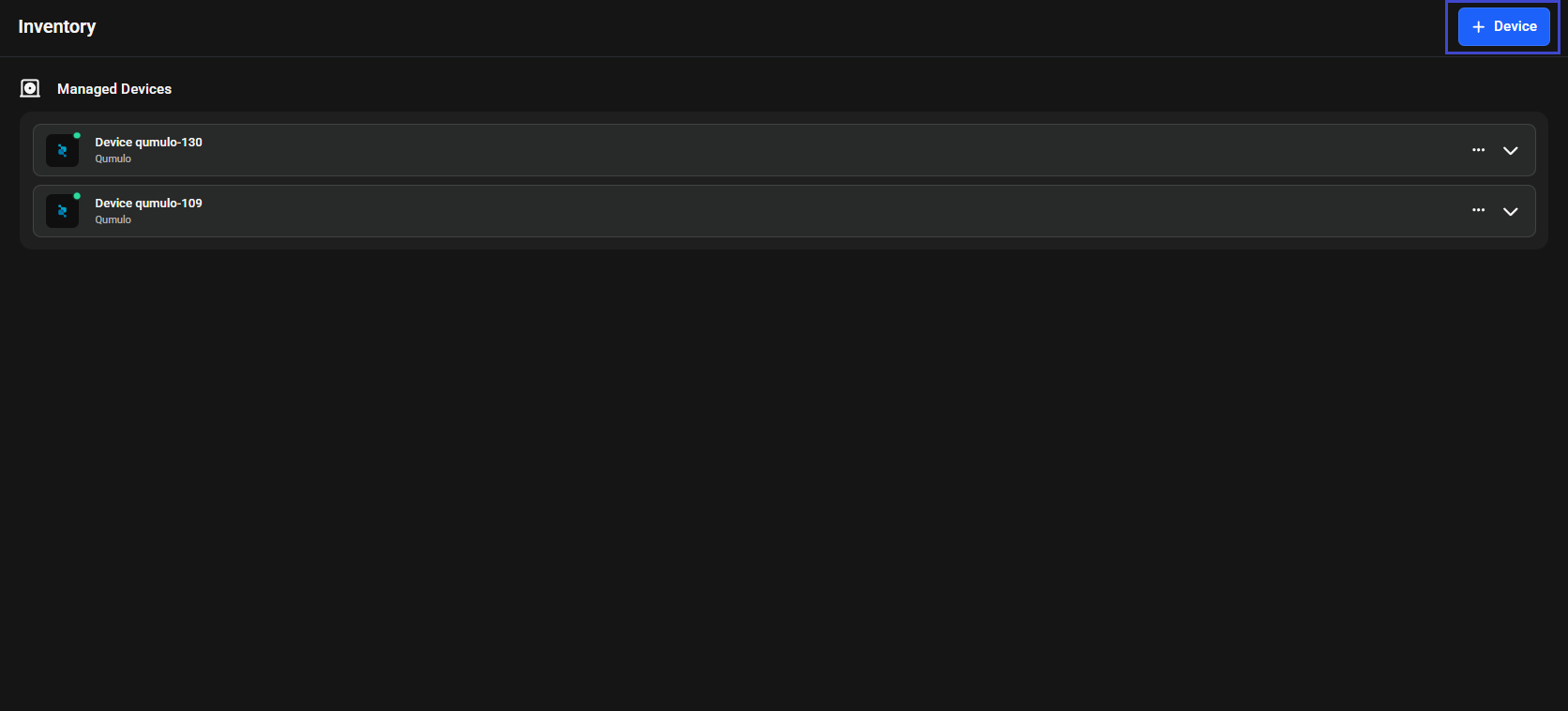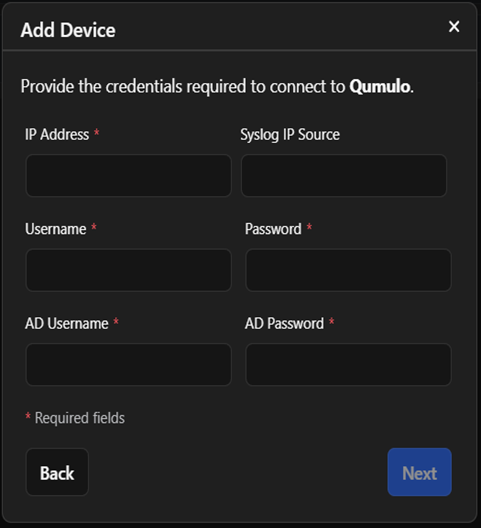Add Qumulo Device
Add a Qumulo storage device to your Superna platform inventory for monitoring and security protection.
Add a Qumulo Device
Add a Qumulo storage device with these steps:
-
Start Device Addition
Click the blue + Device button in the top-right corner.

-
Select Device Type Choose Qumulo from the device type options.
-
Continue Setup Click Next to proceed to the credentials screen.
Configure Qumulo Connection
After clicking Next in the device type selection screen, enter connection details for your Qumulo storage system:
-
Enter Connection Details Fill in the required fields (marked with *):
- IP Address*: The management IP address of your Qumulo system
- Syslog IP Source: IP address for syslog messages (important for audit collection)
- Username*: Administrative username for the Qumulo system
- Password*: Password for the administrative account

After filling in the details, click Next to proceed.
-
Confirm Connection The system will validate the connection credentials. When successful, a popup will appear saying "Connection Successful!" Click the Done button to complete the device addition.
noteThe device will not appear in your inventory until the background job finishes successfully. This typically takes 2-5 minutes.
-
Monitor Job Progress You can monitor the device addition progress in the Jobs section. The system creates a job called "Add Qumulo managed device" that performs these tasks:
- Add Device: Register new device and validate connection credentials
- Store Device: Save managed device data to on-premises database
- Initialize Services: Initialize Device Control service for the managed device
- Collect Inventory: Collect configuration and status information from the device
- Setup Audit: Configure syslog server host and port settings
- Start Audit Service: Initialize device audit service for the managed device
- Activate Managed Device: Activate device and start monitoring user events
ImportantIf the job fails, verify the connection information you provided. Check the IP address, username, and password for accuracy. The account must have sufficient permissions to access the Qumulo system. For detailed troubleshooting steps, see Inventory Troubleshooting.
-
View Device in Inventory After the job completes successfully, the device will appear in your inventory list.
Click the device dropdown in the inventory section to verify the following services have a green icon before them, indicating they are working properly:
- Audit (Online)
- Control (Online)
You can now manage and monitor the device through the Superna platform.

-
Verify Qumulo Auditing (Optional)
After adding the device, it is advised to verify that auditing is properly configured:

-
Access Qumulo Audit Settings Log in to your Qumulo cluster using the same IP address you provided during setup, then navigate to Cluster > Audit
-
Confirm Audit Configuration Verify that the following information appears in the Audit settings:
- Status shows Connected in green text
- Under Configuration, the Remote Syslog Address shows the Superna server address (e.g., hype.k8s.superna.net)
- Port Number shows the correct port (e.g., 10514)
-
Edit Qumulo Device Settings (Optional)
After adding a device to your inventory, you can edit its connection details if needed:
-
Access Device Details
In the Inventory view, locate the device you want to edit.
-
Open Settings
Click the gear icon (⚙️) in the device's row to open the device settings.
-
Modify Details
Update any of the device information as needed:
- IP Address*: The management IP address of your Qumulo system
- Syslog IP Source: IP address for syslog messages (important for audit collection)
- Username*: Administrative username for the Qumulo system
- Password*: Password for the administrative account
-
Save Changes
Click the Update button to save your changes.
When you update device settings, Superna validates the new connection details and reruns the connection jobs to apply the changes.
Next Steps
After adding your Qumulo device, you can configure security monitoring and auditing features:
Threat Detections
Monitor for ransomware and other security threats
Jobs
View and manage automated tasks for your devices
See Also
- Dashboard - Monitor device health and security status
- Threat Detection - Enable security monitoring for your devices
- Jobs - View device-related automated tasks and operations
- First Access - Initial device setup after login